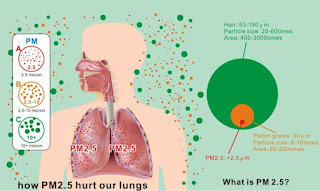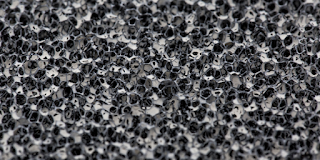What is PM2.5? what is the harmful?
PM2.5 refers to particulates with a diameter less than or equal to 2.5 microns in the atmosphere, also known as particulates that can enter the lungs. It is rich in a large number of toxic and hazardous substances and has a long residence time in the atmosphere and a long transportation distance. Therefore, it is important for human health and The impact of atmospheric environmental quality is even greater. Studies have shown that for every 10 micrograms/cubic meter of PM2.5 daily average, the risk of death from respiratory disease increases by 0.97%, the risk of death from cardiovascular disease increases to 1.22%, and the rate of death from heart and lung disease and cancer Mortality rates increased by 6% and 8%, respectively.
PM2.5 is the critical value to reach the alveoli. PM2.5 fine particles, the upper respiratory tract can not stop, they can all the way down, into the bronchioles, alveoli. Our respiratory system is like a plant root. From top to bottom, the trachea divides the bronchus. The bronchus divides many dense bronchioles. The dense bronchioles are accompanied by dense alveoli. The number of alveoli is 3-4 million. The inhaled oxygen eventually enters the alveoli, passes through the alveolar walls and enters the capillaries, and then enters the entire blood circulation system.
The PM2.5 that we breathe into is too small to enter the alveoli and enter the capillaries through the alveolar wall, which then enters the whole blood circulation system.
PM2.5 carries many harmful organic and inorganic molecules and is the source of illness. Bacteria are a common source of pathogenic diseases. PM2.5 and bacteria have a comparable ratio.
PM2.5 is a fine particle with a diameter of 2.5 μm. The bacteria are micron-sized organisms, and the size is mostly 1 μm, a few μm, and also a dozen μm, that is to say, PM2.5 and bacteria are generally sized.
When bacteria enter the bloodstream, macrophages (a type of immune cells) in the blood will swallow it immediately and it will not make people sick. This is like a tiger eating chicken.
PM2.5 enters the bloodstream. Macrophages in the blood think that it bacteriophages and swallows it immediately. The macrophage swallows bacteria. The bacteria is the living body and is the food of the macrophages. However, PM2.5 is inanimate, and the macrophages swallow it. Like a tiger swallowing a stone, it cannot digest, and it is eventually killed. After a large reduction in macrophages, our immune system will decline.
Not only that, macrophages that have been killed can also release harmful substances that cause inflammation in cells and tissues. It can be seen that PM2.5 is more pathogenic than bacteria, and the more PM2.5 that enters the bloodstream, the more likely we are to become ill
More information pls find: www dot olansigroup dot com
Contact:Melody Xue
Email:sales13 at olansi dot com
Wechat:melody001106
Whatsapp/Mobile:+86 138 2478 4081
PM2.5 is the critical value to reach the alveoli. PM2.5 fine particles, the upper respiratory tract can not stop, they can all the way down, into the bronchioles, alveoli. Our respiratory system is like a plant root. From top to bottom, the trachea divides the bronchus. The bronchus divides many dense bronchioles. The dense bronchioles are accompanied by dense alveoli. The number of alveoli is 3-4 million. The inhaled oxygen eventually enters the alveoli, passes through the alveolar walls and enters the capillaries, and then enters the entire blood circulation system.
The PM2.5 that we breathe into is too small to enter the alveoli and enter the capillaries through the alveolar wall, which then enters the whole blood circulation system.
PM2.5 carries many harmful organic and inorganic molecules and is the source of illness. Bacteria are a common source of pathogenic diseases. PM2.5 and bacteria have a comparable ratio.
PM2.5 is a fine particle with a diameter of 2.5 μm. The bacteria are micron-sized organisms, and the size is mostly 1 μm, a few μm, and also a dozen μm, that is to say, PM2.5 and bacteria are generally sized.
When bacteria enter the bloodstream, macrophages (a type of immune cells) in the blood will swallow it immediately and it will not make people sick. This is like a tiger eating chicken.
PM2.5 enters the bloodstream. Macrophages in the blood think that it bacteriophages and swallows it immediately. The macrophage swallows bacteria. The bacteria is the living body and is the food of the macrophages. However, PM2.5 is inanimate, and the macrophages swallow it. Like a tiger swallowing a stone, it cannot digest, and it is eventually killed. After a large reduction in macrophages, our immune system will decline.
Not only that, macrophages that have been killed can also release harmful substances that cause inflammation in cells and tissues. It can be seen that PM2.5 is more pathogenic than bacteria, and the more PM2.5 that enters the bloodstream, the more likely we are to become ill
More information pls find: www dot olansigroup dot com
Contact:Melody Xue
Email:sales13 at olansi dot com
Wechat:melody001106
Whatsapp/Mobile:+86 138 2478 4081


评论
发表评论